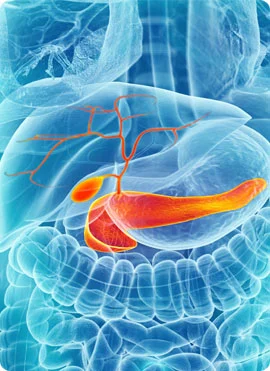Advanced
Biliary Diseases
 What is Advanced Biliary Disease?
What is Advanced Biliary Disease?
As bile is a fluid produced by the liver that aids digestion, biliary disease affects the bile ducts, gallbladder and other structures involved in the production and transportation of bile.
Bile drains from the liver through bile ducts to the first part of the small intestine, or duodenum, and back to the bile ducts and liver. If the ducts become diseased or blocked, a number of serious diseases may result.
Risk Factors
Certain factors may increase the risk of biliary disease, including: heredity, increasing age, obesity, a high-fat diet, certain gastrointestinal conditions and certain prescription medications.
Symptoms of Possible Biliary Disease
Symptoms common to many of the disorders include:
- Abdominal pain, especially in the upper right side of the abdomen under the rib cage
- Nausea or vomiting
- Loss of appetite, or weight loss
- Jaundice (yellowing of the skin and whites of the eyes)
- Fatigue
- Fever/chills
- Itching
- Light brown urine
- Greasy or clay-colored stools
Detection and Diagnosis
Tests commonly performed to diagnose many bile duct disorders may include:
- Blood tests
- Liver function tests
- Ultrasound
- Endoscopic ultrasound
- Computed tomography (CT) scan
- Magnetic Resonance Imaging (MRI)
- Endoscopic retrograde cholangiopancreatography (ERCP)
- Liver biopsy
Treatment
- Patients are treated with Medications to increase the flow of bile from the liver and antibiotics are used to treat infection.
- Endoscopic retrograde choliangiopancreatography (ERCP): This procedure may help identify and remove gallstones from the bile duct.
- Hepatoportoenterostomy: Surgery to drain bile from the liver when bile ducts are blocked.
- Laparoscopic cholecystectomies (removal of the gallbladder)
